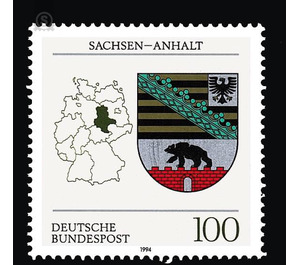Coat of arms of the Land of the Federal Republic of Germany (3) - Germany / Federal Republic of Germany 1994 - 100 Pfennig
Theme: Art & Culture
| Country | Germany / Federal Republic of Germany |
| Issue Date | 1994 |
| Face Value | 100.00 |
| Color | multi-colored white |
| Perforation | K 13 3/4 |
| Printing Type | Multicolor offset printing |
| Stamp Type | Postage stamp |
| Item Type | Stamp |
| Chronological Issue Number | 1587 |
| Chronological Chapter | GER-BRD |
| SID | 126120 |
| In 43 Wishlists | |
The coat of arms of Saxony-Anhalt symbolizes the development of the most important parts of the country; these are the independent Free State of Anhalt until 1945 and the Prussian province of Saxony formed in 1816 without the administrative district of Erfurt, which was separated from the province of Saxony in 1944. The Free State of Anhalt, founded in 1919 from the Duchy of Anhalt, had given itself a new coat of arms on April 4, 1924, following the coat of arms of the Bernburg government. It shows a silver shield, in it a striding black bear on red, black grooved battlements with open gate. The territorially very heterogeneous composite Prussian province of Saxony led since 1817 as a coat of arms a nine times black / gold divided shield, occupied by the obliquely right lying old Saxon green diamond ring. The coat of arms of the province of Saxony, created after a decree of the Prussian state ministry of June 27, 1927, shows in the shield of the semicircular shield in silver a left-looking gold-plated black eagle; underneath the shield is divided nine times gold / black and covered with a green diamond wreath diagonally to the right. The coat of arms of Saxony-Anhalt is linked to the coats of arms of the province of Saxony and the Free State of Anhalt. On July 23, 1945, the provinces of Magdeburg and Halle-Merseburg, newly formed on July 1, 1944, were united with the Free State of Anhalt by the Soviet military administration to become the new province of Saxony. a parliamentary resolution of 3 December 1945 changed its name to the province of Saxony-Anhalt. After the dissolution of the state of Prussia by Control Council Act of 25 February 1947, the province of Saxony-Anhalt was finally constituted with the approval of the Soviet military administration on July 21, 1947 as Saxony-Anhalt. The new coat of arms, which the parliament decided on 14 December 1948, was valid until the formation of the councils of the districts of Halle and Magdeburg in July 1952. It ignored the part of the state of Anhalt and leaned against the coat of arms of the Prussian province of Saxony. After the restoration of the state of Saxony-Anhalt in the context of the German unification process in 1990, the newly elected state parliament decided on January 29, 1991, a new state coat of arms. The coat of arms is divided. The upper part is determined by the old provincial coat of arms: divided nine times gold / black and covered with the green diamond wreath; instead of the eagle in the shield's head is in the upper left third of a silver field with the now right-looking gold-plated black eagle, symbolizing the former affiliation of the province of Saxony to the Prussian state. The lower part of the coat of arms represents the part of the state of Anhalt by taking over the coat of arms of the Free State of Anhalt described above from 1924. (Text: State Archives of the State of Saxony-Anhalt)


